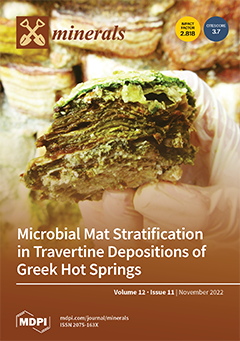In order to provide further insights into the origin of Ru-Os-Ir alloys, this study presents new highly siderophile element (HSE: Re, Os, Ir, Ru, Pt, and Pd) abundance and
187Re-
187Os and
190Pt-
186Os isotope data for detrital grains
[...] Read more.
In order to provide further insights into the origin of Ru-Os-Ir alloys, this study presents new highly siderophile element (HSE: Re, Os, Ir, Ru, Pt, and Pd) abundance and
187Re-
187Os and
190Pt-
186Os isotope data for detrital grains of native Ru-Os-Ir alloys in placer deposits of the Kunar and Unga Rivers, which display a close spatial association with the Kunar dunite–harzburgite complex in the northern part of the Taimyr Peninsula in the Polar Siberia. The study utilized electron microprobe analysis, negative thermal ionization mass-spectrometry (N-TIMS) and laser ablation multiple-collector inductively coupled plasma mass-spectrometry (LA MC-ICP-MS). The primary nature of the Ru-Os-Ir alloys is supported by the occurrence of euhedral inclusions of high-Mg olivine (Fo
92–93) that fall within the compositional range of mantle olivine. The LA MC-ICP-MS data show similar average initial
187Os/
188Os and γ
187Os(740 Ma) values for PGM assemblages from the Kunar and Unga deposits of 0.1218 ± 0.0010, −0.18 ± 0.85, and 0.1222 ± 0.0025, +0.10 ± 2.1, respectively. These values are identical, within their respective uncertainties, to the initial
187Os/
188Os value of the Ru-Os-Ir alloy grain measured by N-TIMS (0.1218463 ± 0.0000015, γ
187Os(740 Ma) = −0.1500 ± 0.0012). The combined
187Re-
187Os isotopic data for all studied grains (γ
187Os(740 Ma) = −0.02 ± 1.6) indicate evolution of the Kunar and Unga mantle sources with a long-term chondritic
187Re/
188Os ratio of 0.401 ± 0.030. In contrast to the
187Os/
188Os data, the initial
186Os/
188Os value of 0.1198409 ± 0.0000012 (µ
186Os(740 Ma) = +34 ± 10) obtained for the same Ru-Os-Ir alloy grain by N-TIMS is suprachondritic and implies evolution of the Kunar and Unga mantle source(s) with a long-term suprachondritic
190Pt/
188Os ratio of 0.00247 ± 0.00021. This value is ~40% higher than the average chondritic
190Pt/
188Os ratio of 0.00180 and indicates long-term enrichment of the Kunar source in Pt over Os. Establishing the source of this enrichment requires further investigation.
Full article





